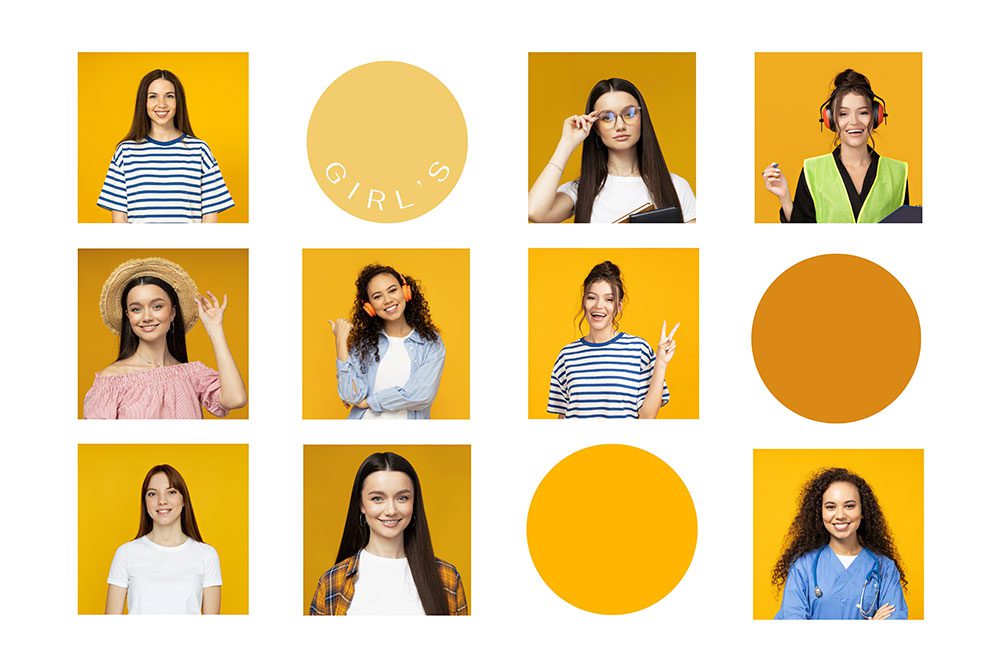10- Typography Rules: Font Types, Sizes, and Hierarchy
Typography plays a vital role in establishing your brand’s identity. It affects how your brand is perceived, communicates your message, and enhances user experience. Effective use of typography involves selecting the right font types, sizes, and structuring them to create a visual hierarchy that guides readers through content.
Font Types
Fonts convey specific messages about your brand’s personality. Choosing the right font types is essential to maintaining consistency and clarity.
a. Serif Fonts
- Characteristics: Serif fonts have small lines (serifs) attached to the end of each letter. They are considered more traditional, formal, and authoritative.
- Examples: Times New Roman, Georgia, Baskerville.
- Best Used For: Print media, luxury brands, editorial content, and formal industries (e.g., law, finance).
- Conveys: Tradition, sophistication, authority, and reliability.
Example: The New York Times uses a serif font to convey authority and a traditional feel.
b. Sans-Serif Fonts
- Characteristics: Sans-serif fonts lack the decorative lines at the end of each letter, offering a cleaner and more modern look.
- Examples: Arial, Helvetica, Calibri, Open Sans.
- Best Used For: Digital content, tech brands, startups, and minimalist design.
- Conveys: Modernity, simplicity, and approachability.
Example: Google uses a sans-serif font (Product Sans) to reflect a modern and friendly brand identity.
c. Script Fonts
- Characteristics: Script fonts mimic handwriting or cursive writing, offering an elegant and often decorative style.
- Examples: Pacifico, Brush Script, Great Vibes.
- Best Used For: Invitations, logos, and luxury brands; they add a touch of elegance but should be used sparingly in body text.
- Conveys: Elegance, creativity, and personal touch.
Example: Luxury brands like Cartier use script fonts in their logos to evoke sophistication and exclusivity.

d. Display Fonts
- Characteristics: Display fonts are highly stylized and unique. They are often bold, quirky, or artistic, designed to grab attention and make a statement.
- Examples: Lobster, Impact, Playfair Display.
- Best Used For: Logos, headers, and limited text in branding materials like posters or ads.
- Conveys: Creativity, boldness, and uniqueness.
Example: The Coca-Cola logo uses a custom display font to create a distinctive and memorable brand identity.
Font Sizes
Font size plays an essential role in the readability and visual hierarchy of content. Here are key considerations for using font sizes effectively:
a. Headings
- Font Size: Headings should be large enough to stand out and attract attention. Typically, headings are sized between 24pt to 48pt, depending on the design.
- Function: Headings serve as signposts, guiding users through the content.
- Best Practice: Use consistent sizes for headings across similar levels (H1, H2, H3) to maintain structure and flow.
b. Subheadings
- Font Size: Subheadings are slightly smaller than main headings but should still be large enough to differentiate from body text (usually between 18pt to 24pt).
- Function: Subheadings break up content into sections, improving readability and giving structure.
c. Body Text
- Font Size: For body text, sizes typically range from 10pt to 16pt, with 12pt to 14pt being the most common for readability.
- Function: Body text should be easy to read, especially for long-form content. Smaller sizes can strain the eyes, while larger sizes may overwhelm the layout.
Example: Websites like Medium use 16pt body text for digital articles, ensuring readability on screens.
d. Call-to-Action (CTA) Text
- Font Size: CTA text is often slightly larger than body text but smaller than headings. It should stand out enough to be noticeable but not distract from the overall content (typically around 16pt to 20pt).
- Best Practice: Use bold or uppercase styles to enhance the CTA’s visibility and effectiveness.
Font Hierarchy
Font hierarchy is essential for guiding the reader’s eye and organizing information effectively. It creates a visual structure that helps prioritize content based on importance.
a. Primary Font
- Role: The primary font is used for headings, titles, and other key elements of a page. It’s typically larger and bolder than the rest of the text to capture attention.
- Best Practice: Use a font that contrasts with the body text to create a clear distinction between headings and paragraphs.
Example: Apple’s website uses bold sans-serif fonts for headings and light sans-serif fonts for body text to create a clean and organized layout.

b. Secondary Font
- Role: The secondary font is used for subheadings, secondary titles, and less prominent text. It should complement the primary font without competing for attention.
- Best Practice: Choose a font with a similar style but slightly less bold than the primary font for subheadings and minor text.
c. Body Font
- Role: The body font is the most frequently used and should prioritize readability over style. It forms the foundation of the typography hierarchy and is usually simple and easy to read.
- Best Practice: Stick to neutral, clean fonts like sans-serifs (Arial, Helvetica) or classic serifs (Georgia, Times New Roman) for body text.
d. Accent Font
- Role: Accent fonts are used sparingly for emphasis (e.g., in callouts, quotes, or CTAs). They should stand out but not overwhelm the other fonts in the hierarchy.
- Best Practice: Use accent fonts in limited areas to create contrast and draw attention.
Spacing and Line Height
Line Height
- Function: Line height (or leading) is the space between lines of text. Proper line height improves readability, especially for long passages of text.
- Best Practice: For body text, the ideal line height is typically 1.4x to 1.6x the font size. This spacing ensures the text is not cramped, making it easier to read.
Example: Websites often use a line height of 1.5x to enhance the readability of articles on mobile and desktop devices.
b. Letter Spacing (Kerning)
- Function: Kerning refers to the space between individual characters. Proper kerning ensures the text doesn’t look too tight or too spaced out.
- Best Practice: Adjust kerning to maintain balance and ensure clarity. Too much spacing can make text appear disjointed, while too little can make it hard to read.
c. Paragraph Spacing
- Function: Spacing between paragraphs breaks up large blocks of text and creates breathing room in the layout.
- Best Practice: Use consistent paragraph spacing to enhance readability, typically around 1.5x the line height.

Consistency Across Platforms
Your typography choices must be consistent across all platforms, whether digital or print, to maintain a cohesive brand image. This includes:
- Web Design: Ensure that font sizes and line spacing are optimized for both desktop and mobile users. Use responsive typography techniques to ensure fonts adjust based on the screen size.
- Print: Make sure the chosen fonts are legible and scalable for business cards, brochures, posters, and other printed materials.
- Social Media: Use your chosen fonts consistently on posts, banners, and advertisements to build brand recognition.
Typography is a fundamental element of your brand’s identity. By carefully selecting font types, setting appropriate sizes, and establishing a clear hierarchy, you can create a cohesive, visually appealing experience that enhances communication and strengthens your brand. Effective typography not only improves readability but also helps convey the personality and tone of your brand, leaving a lasting impression on your audience.
Step 4- Establishing Imagery and Photography Standards
A strong, consistent brand identity is crucial for engaging and retaining your audience. Visual style and mood are key components of your brand’s identity, influencing how your brand is perceived emotionally and aesthetically. To ensure that these components remain cohesive across all platforms, clear guidelines are essential. Imagery and photography standards further enhance this consistency, allowing your brand to communicate effectively with its audience. This guide provides a comprehensive overview of how to establish visual style, mood, and photography standards for your brand.
Defining the Brand’s Visual Style
The visual style of your brand encompasses the overall look and feel of its design elements. From logos to website layouts, the way these elements work together defines the aesthetic tone of your brand. Key components of a brand’s visual style include
Key Elements of Visual Style
Color Palette: A well-defined set of primary and secondary colors ensures visual harmony. The color palette should reflect your brand’s identity. For example, bold, vibrant colors might signal energy and excitement, while muted, neutral tones might represent sophistication, professionalism, or calmness.
Typography: Font choices should align with the tone of your brand. This includes setting rules for font pairing, hierarchy, and usage across platforms (e.g., headers, subheaders, and body text). Whether your brand is formal, playful, modern, or elegant, fonts play a major role in communicating the desired message.
Graphic Elements: Incorporate icons, shapes, patterns, or textures that enhance your brand’s appeal. Graphic elements should be used consistently across all brand materials to reinforce the brand’s identity.
Imagery and Photography: Maintain a consistent photographic style, whether it’s lifestyle-focused, product-focused, or editorial. This will ensure the imagery aligns with your brand’s message and emotional tone.
Example: Minimalist visual styles, often used by tech or luxury brands, rely on clean lines, neutral colors, and ample negative space to convey a sense of modernity and elegance.

Establishing the Brand Mood
The mood of your visuals evokes emotional responses in your audience, directly impacting how they feel about your brand. The mood is a combination of the colors, typography, and imagery used in your visual materials. Identifying the right emotional tone is key to creating a memorable brand experience.
Types of Moods
- Energetic: Bright, contrasting colors, dynamic shapes, and playful fonts convey excitement and vibrancy.
- Calm and Professional: Muted colors, structured typography, and balanced compositions evoke feelings of calmness, trust, and reliability.
- Playful and Fun: A more playful mood can be achieved with vibrant colors, hand-drawn elements, and fun typography to give the brand a lighthearted feel.
- Sophisticated: Darker tones, elegant serif fonts, and symmetrical designs are often used to create a mood of sophistication and luxury.
Example: Outdoor clothing brand Patagonia uses earthy tones and rugged imagery to evoke a mood of adventure and environmental awareness, perfectly aligning with their eco-conscious mission.
Consistency Across Platforms
Consistency in visual style and mood ensures that your audience has a seamless experience with your brand, no matter where they interact with it. Your visual identity should remain consistent across digital media, print materials, and in-person touchpoints.
Areas to Maintain Consistency:
- Digital Media: Your website, social media, and digital advertisements should all reflect the same visual style. Ensure that color schemes, typography, and imagery are cohesive across all digital platforms.
- Print Materials: Your brochures, business cards, packaging, and other print materials should align with your digital presence. This reinforces brand consistency and builds customer recognition.
- User Experience (UX): The visual design of your website or app should be cohesive with your overall brand style, whether minimalistic, bold, or artistic.
Example: Apple applies a clean, minimalistic design approach to everything—from product packaging to in-store displays—ensuring a consistent experience of sophistication and innovation across all brand interactions.
Incorporating Emotionally-Driven Design
Emotionally-driven design is key to creating a deep connection between your brand and its audience. By carefully selecting colors, typography, and imagery, you can evoke the right emotional response.
Emotional Design Approaches:
- Warm and Friendly: Rounded shapes, soft edges, and warm colors create a welcoming, approachable feel.
- Bold and Daring: Sharp edges, high contrast, and deep, intense colors communicate a sense of power and confidence.
- Calming and Soothing: Soft colors, neutral tones, and spacious layouts evoke peace and tranquility.
Example: Brands in the wellness industry, such as the meditation app Calm, often use soft blues and greens, smooth lines, and minimalist designs to create a calming mood.
Aligning Visual Style with Brand Personality
A brand’s visual style should align with its personality, whether professional, quirky, bold, or trustworthy. This alignment strengthens the connection between the brand’s identity and how the audience perceives it.
Brand Personality and Visual Style Alignment:
- Professional and Trustworthy: Use sleek designs, professional fonts (e.g., sans-serif or serif), and neutral or muted colors.
- Fun and Creative: Bright colors, hand-drawn illustrations, and unconventional layouts reflect a playful, creative personality.
Example: Mailchimp uses quirky illustrations and playful colors to communicate a fun, approachable personality, aligning with its user-friendly brand identity.

Cultural and Contextual Considerations
When creating visual guidelines, it’s essential to consider the cultural context of your target audience. Different cultures may interpret colors, symbols, and imagery in unique ways, so it’s important to be mindful of these differences.
Considerations for Global Brands
- Cultural Sensitivity: Some colors or symbols carry different meanings in different cultures. For example, while white symbolizes purity in many Western cultures, it represents mourning in some Eastern cultures.
- Market Fit: A playful mood may resonate with younger audiences, while a more serious and professional style might suit industries like finance or law.
Example: Coca-Cola adapts its visual style to resonate with different markets while maintaining its core brand identity.
Establishing Imagery and Photography Standards
Imagery plays a crucial role in how your brand is perceived. Whether it’s on your website, social media, or print ads, maintaining a cohesive visual language through photography ensures consistency and professionalism. Here are the key elements to consider:
A. Tone and Style of Imagery
Imagery should reflect your brand’s tone and personality. Determine whether your photography is light and airy, dark and moody, polished and high-end, or raw and authentic.
Example: Glossier, a beauty brand, uses bright, minimalistic imagery to convey its modern, effortless identity.
B. Photography Composition
Standards for photography composition include framing, cropping, use of the rule of thirds, focus, and depth of field. Consistency in these areas ensures a uniform visual presentation.
Example: Apple uses minimalistic compositions with ample white space, focusing attention on its sleek, high-tech products.
C. Lighting
The style of lighting used in photography creates a significant impact on mood. Whether natural or dramatic, your lighting choices should align with your brand’s tone.
Example: Coca-Cola integrates its signature red color in imagery, reinforcing its brand identity.
D. Subject Matter and Themes
Define the types of images and themes that represent your brand. This includes deciding whether you will feature lifestyle imagery, product shots, or specific settings, like urban or nature backgrounds.
Example: Airbnb focuses on authentic lifestyle photography showcasing real people in homes, reflecting its personal and accessible brand ethos.
E. Image Quality and Resolution
Ensure all images meet high standards for quality, resolution, and clarity, particularly for digital and print media.
F. Editing and Filters
Maintain consistency in editing styles, including guidelines for post-processing and use of filters to ensure your photos maintain a uniform look.
Visual Examples and Mood Boards
When setting up visual style and imagery guidelines, it’s helpful to include mood boards and visual references to illustrate the desired look and feel. Providing examples of what to do—and what to avoid—helps to guide designers and ensures brand consistency.
Example: A luxury brand might provide specific instructions for photo composition, typography usage, and color application to ensure that all visuals exude sophistication.
By establishing clear guidelines for visual style, mood, and imagery, you ensure that your brand maintains a cohesive identity across all platforms. This consistency helps build trust, recognition, and emotional connection with your audience, ensuring that every interaction they have with your brand feels like part of the same, unified experience.

11- Selecting Imagery That Aligns with Brand Values
Imagery is a powerful tool for conveying a brand’s values, mission, and personality. Selecting the right images can enhance storytelling, foster emotional connections, and reinforce brand identity. Here are key considerations for choosing imagery that aligns with your brand values
Understand Your Brand Values
- Define Core Values: Clearly articulate your brand’s core values. These could include sustainability, innovation, diversity, quality, community, etc. Understanding these values will guide your imagery choices.
- Brand Mission and Vision: Consider how your mission and vision relate to your values. Imagery should reflect not just what your brand does but also why it does it.
Example: A brand like TOMS emphasizes social responsibility. Their imagery often includes diverse individuals and communities benefiting from their “one for one” model, showcasing their commitment to giving back.
Choose Authentic and Relatable Imagery
- Real People and Scenarios: Opt for images featuring real people in genuine situations that reflect your target audience. Authenticity resonates more than overly staged or unrealistic imagery.
- Diversity and Inclusion: Ensure your imagery represents diverse backgrounds, abilities, and experiences to reflect your brand’s commitment to inclusion and equality.
Example: Dove’s “Real Beauty” campaign features real women of different sizes, ages, and ethnicities, reinforcing their values of body positivity and self-acceptance.
Align Imagery with Brand Personality
- Visual Tone: The style of imagery (e.g., bright and playful vs. dark and serious) should align with your brand personality. This ensures that your visuals resonate emotionally with your audience.
- Imagery Style: Choose a photographic style (lifestyle, editorial, product-focused) that complements your brand’s tone and values.
Example: Patagonia uses rugged, outdoor imagery that reflects its adventurous and environmentally-conscious brand personality.

Use Consistent Visual Elements
- Color Palette: Select images that incorporate your brand’s color palette to maintain visual consistency.
- Graphic Elements: Integrate brand-specific graphic elements (e.g., overlays, patterns) into your imagery for a cohesive look.
Example: Coca-Cola often uses red and white in its advertisements, ensuring that images are immediately recognizable and aligned with their brand identity.
Consider Emotional Impact
- Evoke the Right Emotions: Choose imagery that elicits the emotions you want your audience to feel. For example, warm, inviting images can create feelings of comfort and trust.
- Storytelling: Use images that tell a story or convey a message that reflects your brand values. This can create a deeper emotional connection with your audience.
Example: Nike often uses powerful imagery of athletes overcoming challenges, conveying messages of determination and empowerment that align with their brand ethos.
Incorporate Values into Imagery Context
- Setting and Background: The context in which subjects are photographed can enhance or dilute the message. Ensure settings align with your brand values (e.g., natural settings for eco-conscious brands).
- Props and Activities: Consider using props or activities that symbolize your brand’s values. This helps reinforce your message visually.
Example: A brand focused on health and wellness might use imagery of fresh produce and active lifestyles to convey its commitment to healthy living.
Ethical Considerations
- Avoid Stereotypes: Steer clear of imagery that perpetuates stereotypes or misrepresents groups. Ensure your imagery is respectful and reflects the diversity of your audience.
- Source Responsibly: If using stock photography, choose images from ethical sources that represent real people and avoid exploitative practices.
Example: Brands like Ben & Jerry’s emphasize social justice and environmental stewardship in their imagery, ensuring it aligns with their ethical values.

Test and Gather Feedback
Audience Testing: Share imagery options with target audiences to gauge their reactions. This can provide insights into whether the images resonate with your brand values.
Iterate Based on Feedback: Be willing to adjust your imagery choices based on audience feedback to ensure alignment with their perceptions and values.
Example: A fashion brand might test different styles of imagery on social media to see which resonates most with its audience, allowing for adjustments to better align with brand values.
Document and Create Guidelines
- Imagery Guidelines: Create guidelines that outline how to select and use imagery in marketing materials. Include examples of what aligns with your brand values and what does not.
- Visual Library: Build a library of approved images that reflect your brand values. This helps ensure consistency across marketing channels.
Example: A non-profit organization might create a visual library of imagery that showcases its mission in action, ensuring all team members have access to approved visuals.

12- Photography Dos and Don’ts
Effective photography is crucial for conveying your brand’s message and values. Here are essential dos and don’ts to ensure your imagery is impactful and aligns with your brand identity.
Dos
Do Define Your Purpose
- Clarify Goals: Understand the purpose of your photos—whether it’s to showcase a product, tell a story, or evoke emotions.
- Align with Brand Values: Ensure your photography reflects your brand’s mission and core values.
Do Use High-Quality Images
- Invest in Good Equipment: Use high-resolution cameras and lenses to capture sharp, clear images.
- Hire Professionals: Consider hiring a professional photographer for important shoots to ensure quality.
Do Consider Composition
- Rule of Thirds: Use the rule of thirds to create balanced and engaging compositions. Position key elements along the lines or at intersections.
- Leading Lines: Use natural lines in the scene to guide the viewer’s eye toward the subject.
Do Pay Attention to Lighting
- Natural Light: Whenever possible, use natural light for softer, more flattering images. Early morning or late afternoon light is often ideal.
- Avoid Harsh Shadows: Be mindful of shadows; use diffusers or reflectors to soften light if shooting outdoors.
Do Ensure Consistency
- Cohesive Style: Maintain a consistent style across all images, including color palettes, tones, and photography techniques.
- Brand Guidelines: Refer to your brand’s visual identity guidelines to keep imagery aligned.
Do Showcase Authenticity
- Real People and Situations: Use candid shots of real people in relatable situations to enhance authenticity.
- Behind-the-Scenes Shots: Include behind-the-scenes imagery to give audiences a glimpse into your brand’s culture and processes.
Do Use Props Thoughtfully
- Enhance the Story: Use props that add context and enhance the narrative without distracting from the main subject.
- Relevance: Ensure props align with your brand values and message.
Do Edit with Care
- Post-Processing: Use editing software to enhance images without over-editing. Aim for a natural look that still aligns with your brand style.
- Color Grading: Use consistent color grading to unify the visual tone across your photography.

Don’ts
Don’t Use Low-Quality Images
- Avoid Pixelation: Steer clear of low-resolution images that appear blurry or pixelated, as they undermine professionalism.
- Skip Stock Photos: Avoid clichéd stock photos that feel inauthentic or generic, unless they can be made unique.
Don’t Ignore the Background
- Cluttered Backgrounds: Avoid busy or distracting backgrounds that take attention away from the subject.
- Context Matters: Ensure the background enhances the narrative and aligns with your brand story.
Don’t Overlook Lighting Issues
- Avoid Overexposure and Underexposure: Be cautious of harsh lighting that washes out details or obscures important features.
- Flash Misuse: Use flash sparingly; harsh flash can create unflattering shadows and highlights.
Don’t Be Inconsistent
- Varying Styles: Avoid drastically different styles or tones across images, as this can confuse your audience.
- Brand Misalignment: Ensure all images reflect your brand’s identity; inconsistent imagery can weaken brand recognition.
Don’t Forget to Tell a Story
- Staged vs. Real: Avoid overly staged photos that lack authenticity. Aim for images that tell a genuine story.
- Missing Emotion: Don’t neglect emotional impact; choose images that evoke feelings related to your brand values.
Don’t Use Unapproved or Unlicensed Imagery
- Copyright Issues: Avoid using images without permission or proper licensing to prevent legal issues.
- Brand Inconsistency: Using unapproved images can create dissonance with your established brand identity.
Don’t Over-Edit
- Avoid Over-Saturation: Excessive editing can lead to unrealistic images. Aim for a polished yet authentic look.
- Maintain Naturalness: Ensure your images still feel genuine and relatable, not overly retouched or artificial.
Don’t Forget to Adapt
- Ignore Different Platforms: Tailor your images for different platforms and formats (social media, website, print) to optimize impact.
- Neglect Audience Preferences: Consider the preferences and expectations of your target audience when selecting imagery.

Step 5: Creating Rules for Content Creation
In today’s digital landscape, content plays a pivotal role in building and maintaining a brand’s identity, reaching target audiences, and driving engagement across platforms. Whether through blog posts, social media updates, videos, or podcasts, the content a brand produces becomes a key touchpoint for potential customers. To ensure that your content consistently reflects your brand values, engages your audience, and meets your business objectives, it’s essential to establish clear rules for content creation.
Creating rules for content creation not only provides structure for teams but also ensures that every piece of content aligns with the brand’s voice, tone, objectives, and audience expectations. This guide delves into the importance of creating comprehensive content creation rules and outlines the essential components to include in your guidelines.
Why Content Creation Rules Matter
Content creation rules are essential for several reasons:
- Efficiency for Content Teams: With clear rules in place, content creators know exactly what’s expected of them, which reduces ambiguity and the need for constant revisions. These guidelines also help streamline the content approval process by setting clear expectations.
- Audience Engagement: By creating rules that align with your audience’s preferences, interests, and needs, you can produce content that resonates more effectively. Content that speaks directly to the audience increases engagement and encourages stronger relationships with customers.
- Improved Quality: When content creators follow specific guidelines, the overall quality of the content improves. Rules help avoid common mistakes, ensure accuracy, and maintain a high standard for all forms of content, whether it’s written, visual, or multimedia.
- Brand Identity Reinforcement: Clear content creation rules reinforce your brand’s identity. Every piece of content should echo the core values, mission, and vision of the brand, creating a unified voice that resonates with your audience.
Components of Content Creation Rules
Creating comprehensive content creation rules involves several key components. These guidelines should cover everything from brand voice to formatting, visual elements, and content types. Let’s explore each component in detail:
A. Defining Brand Voice and Tone
Your brand’s voice is the unique personality and style that comes through in all content. It reflects who you are as a company and how you want to engage with your audience. Tone, on the other hand, refers to the emotional inflection in your content, which can vary depending on the context or the platform.
Steps to Define Brand Voice:
- Identify Brand Personality: Consider adjectives that describe your brand. Are you formal and authoritative or casual and friendly? Your brand voice should reflect your core identity.
- Audience-Centric: Tailor your voice to the audience you’re targeting. If your audience is young and tech-savvy, a more casual, fun tone may resonate better than a corporate, formal tone.
- Tone Variability: Establish when and how your tone might change based on the context. For example, a blog post might be conversational, but a press release may need a more formal tone.
Example:
- Brand Voice: Friendly, approachable, informative.
- Tone Variability: Conversational and humorous on social media; authoritative and professional in white papers.
B. Content Objectives and Purpose
Each piece of content should serve a clear purpose and align with your overall content strategy. Whether the goal is to inform, entertain, inspire, or convert, it’s important to outline the objectives behind every type of content you create.
Steps to Set Content Objectives:
- Align with Business Goals: Content should support broader business goals, such as increasing brand awareness, generating leads, or boosting customer loyalty.
- Define KPIs: Identify key performance indicators (KPIs) to measure the success of your content. For example, KPIs might include website traffic, social media engagement, or conversion rates.
- Content’s Role in the Funnel: Establish what stage of the buyer’s journey the content is targeting. Top-of-the-funnel content (awareness) will look very different from bottom-of-the-funnel content (conversion).

C. Formatting and Style Guidelines
Formatting rules ensure that content is easy to read, accessible, and consistent across different platforms. These guidelines cover everything from blog post length to font choices and paragraph structure.
Formatting Components:
- Post Length: Set clear guidelines for different types of content. For example, blog posts might need to be 800–1,500 words, while social media updates should be concise and to the point.
- Headings and Subheadings: Ensure that headings are used consistently to break up content and improve readability. Provide rules for heading levels (e.g., H1 for main titles, H2 for subheadings).
- Paragraphs and Sentences: Establish limits on paragraph length (e.g., no longer than three sentences) and encourage the use of short, clear sentences for readability.
- Grammar and Punctuation: Provide a guide for grammatical preferences, including whether to use the Oxford comma, hyphenation rules, and preferred style manuals (e.g., AP Style, Chicago Manual of Style).
Example: HubSpot maintains a clean, user-friendly blog format with short paragraphs, bullet points, and clear subheadings, making their content digestible for readers.
Visual Elements and Imagery
Content creation is not just about words; visuals play a significant role in how content is consumed and understood. It’s essential to provide guidelines for visual content that align with your brand’s identity.
Visual Guidelines to Include:
- Image Style: Outline the types of images your brand should use, whether they’re stock images, custom illustrations, infographics, or user-generated content. Ensure that these visuals align with your brand’s visual identity.
- Image Sourcing: Provide rules for where to source images, whether through licensed stock photography sites, in-house design teams, or collaborations with content creators.
- Image Quality and Resolution: Ensure that all visuals meet quality standards, including high resolution for web and print.
- Brand Colors and Logos: If your visuals include brand logos or colors, specify how and when these elements should appear. This might include rules for logo placement, color schemes, or the application of watermarks.
E. Content Types and Platform-Specific Guidelines
Different content formats and platforms require unique approaches. From social media to blogs and videos, it’s important to provide specific rules for each content type.
Content Types to Consider:
- Blog Posts: Provide guidelines for length, structure, SEO best practices (keywords, meta descriptions, alt text), and linking strategies (internal and external links).
- Social Media Posts: Establish platform-specific rules for character limits, hashtags, emojis, and tagging. For example, Instagram posts may be more visually focused, while LinkedIn posts might require a professional, polished tone.
- Videos and Podcasts: Provide guidelines for the length, format, and tone of multimedia content. Ensure that these content pieces align with your brand’s voice and target the appropriate audience.
- Email Newsletters: Define rules for subject lines, email copy, and call-to-action placement. Ensure that emails are personalized and reflect the tone of voice your audience expects from your brand.
Example:
- Twitter Posts: Max 280 characters, one branded hashtag, and use emojis sparingly.
- YouTube Videos: 5–10 minutes in length, with a focus on engaging storytelling and a clear call to action at the end.

F. SEO and Content Optimization
Search engine optimization (SEO) is a critical part of content creation, as it ensures your content is discoverable by your audience. SEO rules guide content creators on how to optimize their work for search engines without sacrificing quality or readability.
SEO Best Practices to Include:
- Keyword Research: Define how to conduct keyword research and provide guidelines for keyword placement (in titles, headings, and body text).
- Meta Descriptions and Titles: Provide rules for writing effective meta descriptions and title tags that incorporate targeted keywords.
- Linking Strategy: Ensure that content creators include internal links to related content and external links to high-authority sources.
- Alt Text and Accessibility: Include guidelines for writing descriptive alt text for images, ensuring that content is accessible to all users.
G. Approval Process and Editorial Workflow
To ensure content quality and consistency, it’s important to have a clear approval process in place. This helps streamline content production while ensuring that every piece aligns with your brand’s standards.
Steps to Create an Approval Process:
- Drafting: Outline who is responsible for drafting content and what tools or platforms (e.g., Google Docs, WordPress) will be used for content creation.
- Editing: Assign specific team members to review content for grammar, style, SEO optimization, and adherence to brand guidelines.
- Approval: Establish a final approval process that includes content managers, brand leaders, or legal teams (if necessary).
- Publishing: Set clear rules for when and where content will be published, including scheduling tools for social media or blog posts.
H. Legal and Ethical Considerations
Content creation should also adhere to legal and ethical standards. Ensure that your rules include guidance on intellectual property, data privacy, and ethical issues.
Legal Considerations:
- Copyright and Licensing: Ensure that all images, videos, and content adhere to copyright laws and are properly licensed.
- Data Protection: If your content involves user data, make sure it complies with data privacy regulations (e.g., GDPR) and that permissions are obtained for any user-generated content.
I. Measuring Success and Analytics
Once content is published, it’s important to track its performance to understand what resonates with your audience and how you can improve future content. Provide guidelines for how to measure success and track important metrics.
Metrics to Track:
- Engagement Metrics: Measure likes, comments, shares, and time spent on the page to gauge how well the content is engaging your audience.
- Conversion Metrics: Track the number of leads, downloads, or purchases generated by specific pieces of content.
- SEO Metrics: Monitor your content’s performance on search engines by tracking keyword rankings, organic traffic, and backlinks.
Continue Reading
- How to Create Comprehensive Branding Guidelines- A Step by Step Guide / Part 1
- How to Create Comprehensive Branding Guidelines- A Step by Step Guide / Part 2
- How to Create Comprehensive Branding Guidelines- A Step by Step Guide / Part 3
- How to Create Comprehensive Branding Guidelines- A Step by Step Guide / Part 4
- How to Create Comprehensive Branding Guidelines- A Step by Step Guide / Part 5
- How to Create Comprehensive Branding Guidelines- A Step by Step Guide / Part 6
Written By: Zahraa El Husseini

